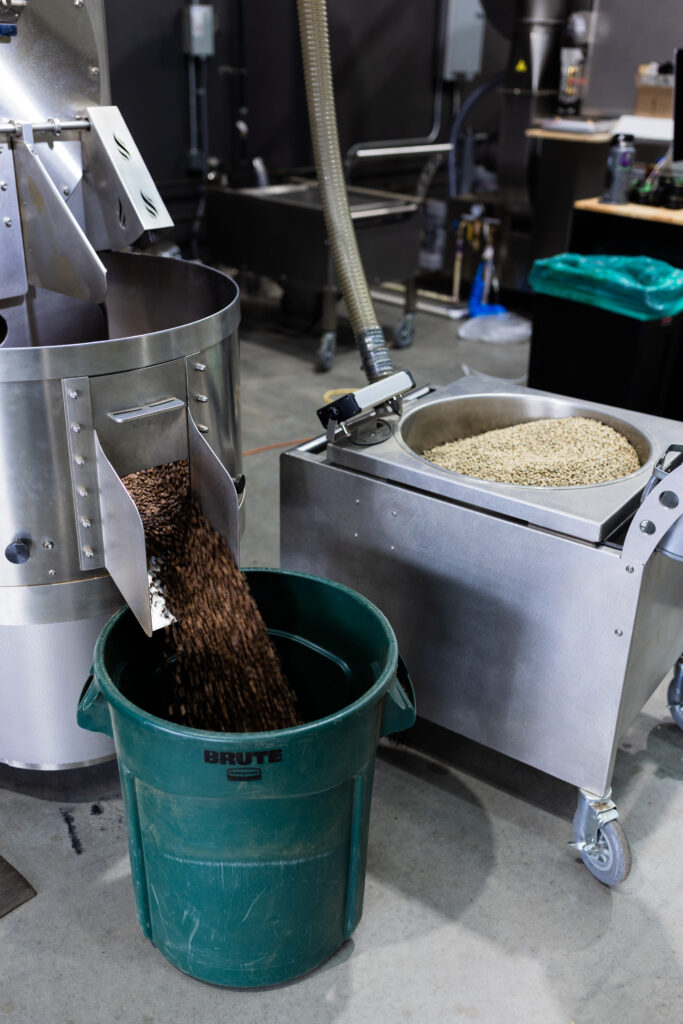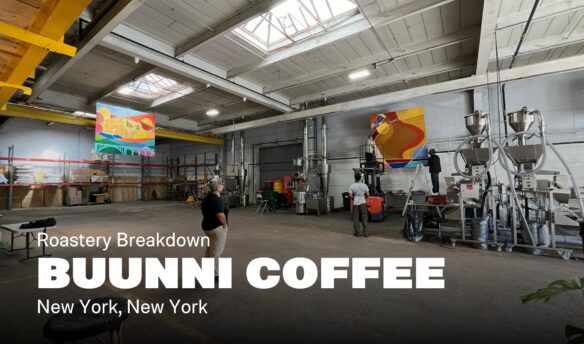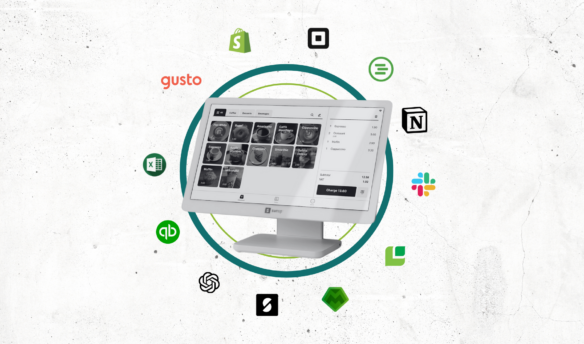The Roastery Breakdown series is presented by our partner, Loring.
Three years ago, Matt Ferraro found himself roasting coffee for Black and White Coffee Roasters in Raleigh, North Carolina, in 90-degree heat.
“[It was] a really nice space, but with Black and White growing, it was not really well set up,” he says of the roasting space. “Like the roaster was in one corner and production was in another, and [we were] kind of just piecing it together in this big room.”
The company has grown exponentially since its founding in 2017 and has since moved its roasting operations to the next unit. The roasting space now is temperature-controlled and big enough to handle the volume of coffee that Black and White pumps out. Ferraro, the Director of Roasting and Operations at Black and White, works to create a roastery that produces excellent coffee and values teamwork and employee wellbeing.
Founded by Kyle Ramage and Lem Butler, Black and White has three retail locations, a roastery that roasts coffee for its cafes, numerous wholesale accounts, and a growing in-house instant coffee program.
The roastery feels like a modern coworking space, adorned with art in the lab and the bathroom by Atlanta-based artist Ghost Town and murals by Brian Spillman. The space reflects Black and White’s team-focused and transparent approach to coffee: for example, the lab, where Ferraro and Ramage cup coffees and determine roast profiles, has a large window so anyone in the roasting space can see what’s happening.



“We had this window put in here to have this insight into the roastery, not only to see out of but also for the whole team to see in,” says Ferraro. “Not to have it behind closed walls.”
Fast Facts:
Roastery Location: Raleigh, North Carolina
Square Footage: 14,000 square feet
Pounds Roasted: 10,000 lbs per week
Retail and/or Wholesale Roasting: Both
So Many Choices
The roastery is a space built with efficiency and teamwork in mind. “We try to have everyone follow a straight line and no extra steps,” says Ferraro. “[We’re] trying to be as efficient as we can.” Black and White’s roastery lives in what looks like an unassuming set of office buildings but is actually a warehouse with three bay doors, a Loring S15 Falcon, a Loring S35 Kestrel, a Loring S70 Peregrine, and a fully-equipped lab where, along with cupping, the team gathers to set menus and take meetings with wholesalers.


There is no shortage of roasting machines out on the market. Ferraro says the choice to go with Loring was informed by the machine’s ease of use and the quality of coffee they saw others using Lorings achieve. “The flavor and potential that we’ve seen out of the Loring is what drove [us],” he says. “We’ve had a lot of success with it, especially with the coffees we buy and roast.” The more high-tech functions of a Loring, such as automated roasts, high heat sensors, and automatic door openings by temperature, have also made training new roasters easier.
With three Loring roasters, Ferraro loves breaking down what coffees to roast on which machine. “The volume of the coffee decides which roaster it will work through,” he says. “We release two to three coffees a week, and I will set a profile for each coffee on each machine. This can be up to nine new profiles a week!”
Despite profiling all the coffees on each machine, Ferraro says there’s some predictability. “For the most part, our year-round coffees are larger by volume and will be roasted on the 70-kilo Peregrine for most efficiency,” he says. “Our competition-level coffees (aka our Black Label Coffees) are always roasted on the 15-kilo Loring Falcon. The Falcon has incredible accuracy and control.”
Choosing which roaster to use is all about purpose. “I always refer to the Falcon as the sports car and the Peregrine as the bus or freight train. The 35-kilo Kestrel is our daily driver—it can do it all and is incredibly versatile,” says Ferraro. “So [it’s about] managing the overall volume but also the weight distribution between roasters. Trying to establish an even workload amongst all three roasters is nuanced, to say the least.”
Equipment Breakdown
No Quakers Here: Black and White uses a Sovda Pearl Mini Optical Sorter to sort through their coffees for quakers, rocks, and anything else that may end up in a bag of green coffee. “We try to have as many of those stopgaps for quality control, for metal, for rocks, and the reality is that no matter how high quality some of these coffees are, these things still happen.”
While products like this can be expensive, the results speak for themselves. “This year, we had some Ethiopian coffees that we had some trouble with—there were some quality issues, and we definitely saw a lot of quakers. I think that without this Sovda, those Ethiopias would not have made it to our single origin menu.”
Keeping Coffee Cool: Underneath racks of green coffee bags, Black and White has two freezers they use to store high-value green coffee lots to keep at peak freshness. Utilizing freezers allows them to freeze the coffee “right in place” so that they can be more flexible when purchasing green coffee.
“Basically, if we have access to them, we’ll pick them up,” says Ferraro, instead of worrying about coffees aging or getting stale before they’re roasted. Storing green coffees in freezers still requires careful packaging and care to remove any moisture that could damage these high-value lots, but it allows Black and White to always have coffees for their Black Label releases on hand.
Pour Overs with PourSteady: The Black and White lab has an espresso machine, sample roaster, and a 5-cup PourSteady PS1 Automatic Pour Over Machine. The staff uses this for daily coffee drinking, but Ferraro says it’s also an essential tool for wholesale tastings and making decisions broadly about the coffees they roast.
He explains the uses for the PourSteady around the roastery are “research, trying new filters and trying comparison brews, [testing] grinders, or just doing larger format tastings with wholesalers.” There’s also a PourSteady in each of Black and White’s cafes.
Go With The Flow: The roastery has four main parts: the lab, an area for green coffee storage, the roasting area, and the packaging and order fulfillment areas. The team added a second line to their production space a year and a half ago to meet growing demand.
The decision to add that second line was based on looking at each area and where delays were happening when fulfilling orders. “[We were] feeling like production was the big pinch. We had coffee ready, and fulfillment would be waiting, but the coffee just wasn’t getting bagged fast enough, so the first thing we did was upgrade to our QuantumPak vacuum sealer.”
Since adding a second line and utilizing all three roasters, the team has been able to manage orders for their retail cafes and the growing number of orders from the Black and White website, including subscription services.
Teamwork Makes The Dreamwork
Teamwork is everything to the roasting staff at Black and White, and people often jump in to help one another once their work is done. “The roasting team usually finishes up by noon or one,” says Ferraro, “Production is still running and finishing up, and the fulfillment team is setting [orders] up. Once the production team is bagging up the new coffees, we’ll jump in and all finish the day together.”

Black and White chooses equipment based on its team’s needs. Perhaps the best example of this is the choice of adding the 70-kilo Peregrine. As Black and White became more popular and volume increased, the roasting team was faced with a challenge: “We had a few options,” says Ferraro. We could start work earlier, add a fifth day to the work week (the team currently works four days a week), or add new equipment to remedy the issue.”
Instead of stretching the team’s capacity, Black and White decided that adding a higher-capacity roaster would offer the best solution—and centered the needs and wellbeing of the team. This team focus has helped guide all the decisions made at Black and White and helped make the roastery efficient and well-structured. “When we reflect back on our values and what has continued to help us thrive here,” says Ferraro, “the decisions have become easier to make.”
Photos courtesy of Black and White Coffee Roasters

















